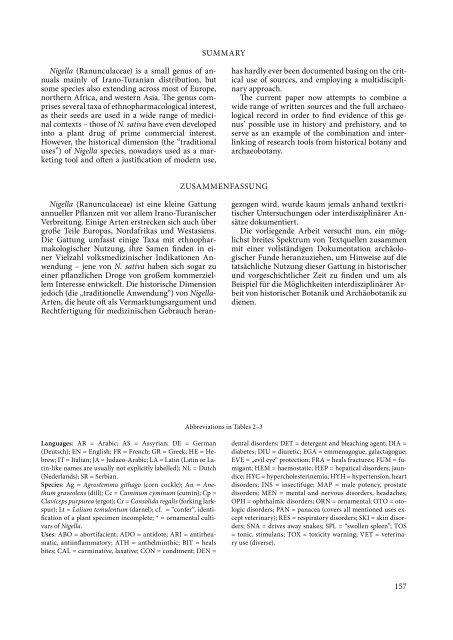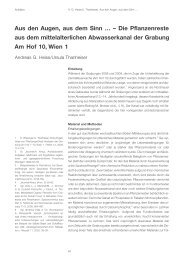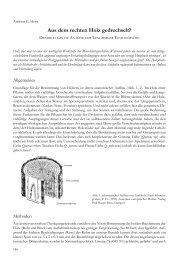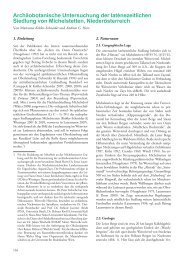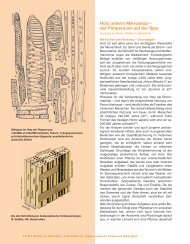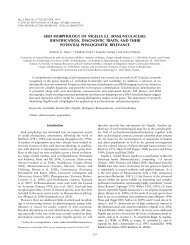View - erbsenzaehler.at
View - erbsenzaehler.at
View - erbsenzaehler.at
Create successful ePaper yourself
Turn your PDF publications into a flip-book with our unique Google optimized e-Paper software.
Summary<br />
Nigella (Ranunculaceae) is a small genus of annuals<br />
mainly of Irano-Turanian distribution, but<br />
some species also extending across most of Europe,<br />
northern Africa, and western Asia. The genus comprises<br />
several taxa of ethnopharmacological interest,<br />
as their seeds are used in a wide range of medicinal<br />
contexts – those of N. s<strong>at</strong>iva have even developed<br />
into a plant drug of prime commercial interest.<br />
However, the historical dimension (the “traditional<br />
uses”) of Nigella species, nowadays used as a marketing<br />
tool and often a justific<strong>at</strong>ion of modern use,<br />
has hardly ever been documented basing on the critical<br />
use of sources, and employing a multidisciplinary<br />
approach.<br />
The current paper now <strong>at</strong>tempts to combine a<br />
wide range of written sources and the full archaeological<br />
record in order to find evidence of this genus’<br />
possible use in history and prehistory, and to<br />
serve as an example of the combin<strong>at</strong>ion and interlinking<br />
of research tools from historical botany and<br />
archaeo botany.<br />
Zusammenfassung<br />
Nigella (Ranunculaceae) ist eine kleine G<strong>at</strong>tung<br />
annueller Pflanzen mit vor allem Irano-Turanischer<br />
Verbreitung. Einige Arten erstrecken sich auch über<br />
große Teile Europas, Nordafrikas und Westasiens.<br />
Die G<strong>at</strong>tung umfasst einige Taxa mit ethnopharmakologischer<br />
Nutzung, ihre Samen finden in einer<br />
Vielzahl volksmedizinischer Indik<strong>at</strong>ionen Anwendung<br />
– jene von N. s<strong>at</strong>iva haben sich sogar zu<br />
einer pflanzlichen Droge von großem kommerziellem<br />
Interesse entwickelt. Die historische Dimension<br />
jedoch (die „traditionelle Anwendung“) von Nigella-<br />
Arten, die heute oft als Vermarktungsargument und<br />
Rechtfertigung für medizinischen Gebrauch herangezogen<br />
wird, wurde kaum jemals anhand textkritischer<br />
Untersuchungen oder interdisziplinärer Ansätze<br />
dokumentiert.<br />
Die vorliegende Arbeit versucht nun, ein möglichst<br />
breites Spektrum von Textquellen zusammen<br />
mit einer vollständigen Dokument<strong>at</strong>ion archäologischer<br />
Funde heranzuziehen, um Hinweise auf die<br />
t<strong>at</strong>sächliche Nutzung dieser G<strong>at</strong>tung in historischer<br />
und vorgeschichtlicher Zeit zu finden und um als<br />
Beispiel für die Möglichkeiten interdisziplinärer Arbeit<br />
von historischer Botanik und Archäobotanik zu<br />
dienen.<br />
Abbrevi<strong>at</strong>ions in Tables 2–3<br />
Languages: AR = Arabic; AS = Assyrian; DE = German<br />
(Deutsch); EN = English; FR = French; GR = Greek; HE = Hebrew;<br />
IT = Italian; JA = Judaeo-Arabic; LA = L<strong>at</strong>in (L<strong>at</strong>in or L<strong>at</strong>in-like<br />
names are usually not explicitly labelled); NL = Dutch<br />
(Nederlands); SR = Serbian.<br />
Species: Ag = Agrostemma githago (corn cockle); An = Anethum<br />
graveolens (dill); Cc = Cuminum cyminum (cumin); Cp =<br />
Claviceps purpurea (ergot); Cr = Consolida regalis (forking larkspur);<br />
Lt = Lolium temulentum (darnel); cf. = “confer”, identific<strong>at</strong>ion<br />
of a plant specimen incomplete; * = ornamental cultivars<br />
of Nigella.<br />
Uses: ABO = abortifacient; ADO = antidote; ARI = antirheum<strong>at</strong>ic,<br />
antiinflamm<strong>at</strong>ory; ATH = anthelminthic; BIT = heals<br />
bites; CAL = carmin<strong>at</strong>ive, lax<strong>at</strong>ive; CON = condiment; DEN =<br />
dental disorders; DET = detergent and bleaching agent; DIA =<br />
diabetes; DIU = diuretic; EGA = emmenagogue, galactagogue;<br />
EVE = „evil eye“ protection; FRA = heals fractures; FUM = fumigant;<br />
HEM = haemost<strong>at</strong>ic; HEP = hep<strong>at</strong>ical disorders, jaundice;<br />
HYC = hypercholesterinemia; HYH = hypertension, heart<br />
disorders; INS = insectifuge; MAP = male potency, prost<strong>at</strong>e<br />
disorders; MEN = mental and nervous disorders, headaches;<br />
OPH = ophthalmic disorders; ORN = ornamental; OTO = otologic<br />
disorders; PAN = panacea (covers all mentioned uses except<br />
veterinary); RES = respir<strong>at</strong>ory disorders; SKI = skin disorders;<br />
SNA = drives away snakes; SPL = “swollen spleen”; TOS<br />
= tonic, stimulans; TOX = toxicity warning; VET = veterinary<br />
use (diverse).<br />
157


